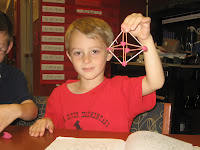This week Kindergarten students have been taking pipe cleaners twisting them into circles for a closed shape and then bending and molding them into different 2D shapes that they will end up growing crystals on. I found the idea on Pinterest and thought I would try it with the Kindergarten students. The students LOVE seeing the water go from cloudy (right after the Borax is added) to clear. And then, coming in the next class to see their shapes have crystals on them!

First and Second Grade students have been exploring 3 dimensional shapes and polyhedrons. I found a silly video from Teacher Tipster on YouTube that the kids love (He makes them laugh!) about some 3D shapes using common items. We have also been exploring the 3D shapes using tooth picks and clay while working in pairs. (It helps to have an extra set of hands!) I was able to get a few shots of some of the students with their 3D shapes for my board, will post some of them below as well. Second grade will be moving on in 3D shapes and creating 3D skeleton shapes from rolled up newspaper.
Third Grade has been exploring shapes and using them to introduce fractions. This is a lesson that I have done before with fourth graders to help them see parts and wholes in fractions. We also had Mr. Joe McNaughton come in and do the same lesson with the teachers during a PLC recently. I thought it might be a nice way to introduce the concept of fractions to third graders as well. The students have been using the triangles, parallelograms, trapezoids, and hexagons from the pattern blocks and trying to find the parts if one of the shapes represents a whole. Fox example, if a hexagon is the whole, then a triangle is one-sixth. However, if the triangle is the whole, then the hexagon is six. And so on. Fractions are still very, very new to them right now. So will probably save this lesson for later on in the year and review it with them to see the difference after they have gone through the fractions unit in their homeroom classes.
Next up for the third graders will be straw towers - learning about the shapes, loads and forces on a structure, and then constructing a straw tower that is able to withstand wind forces (or fan forces :)
The fourth and fifth graders have already begun their Famous Florida Structures projects. This is appropriate with the fourth graders taking their class trip to St. Augustine. The students are working in pairs (or three-somes in some cases) to research a famous Florida structure, find out about its construction, the materials that were used in the structure, its history, the architect or engineers in charge of the construction, and its importance to Florida. They will be taking this information and writing some of the facts on the faces of 3D nets and then forming 3D shapes out of them. They will also be giving oral presentations and sharing with the rest of the class the information they have found on these structures. (This will help them get ready for their speeches they will be writing later in the year.)












